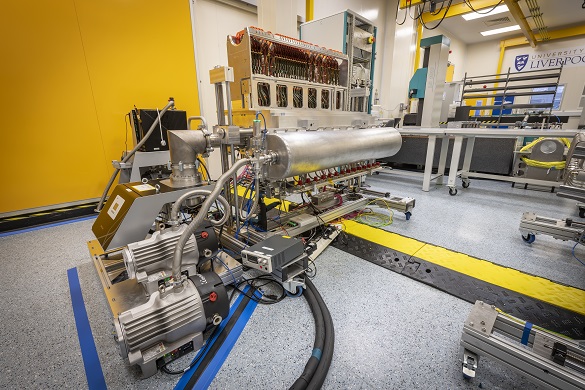The device hoping to answer the ultimate existential questions
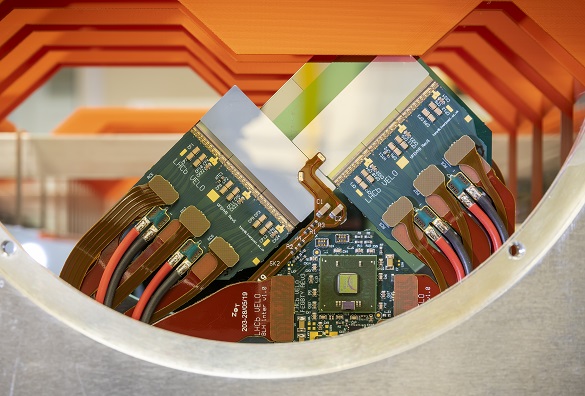
The final piece of an all-new detector has completed the first leg of its journey towards unlocking some of the most enduring mysteries of the Universe.
The 41-million-pixel Vertex Locator (VELO) was assembled at the University of Liverpool from components made at different institutes, before it travelled to its home at the LHCb experiment at CERN.
Once installed in time for data-taking, it will attempt to answer the questions: why is the Universe made of matter, not antimatter, why does it exist at all, and what else is out there?
Development of the new VELO detector was led by the UK, funded by the Science and Technology Facilities Council (STFC) and involves the universities of Liverpool, Bristol, Glasgow, Manchester, Oxford, and Warwick.
Image: VELO side C leaving the University of Liverpool's Department of Physics
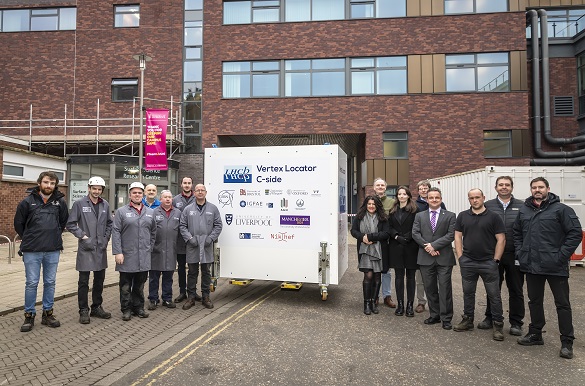
A fine balance at the dawn of space and time
In the moments immediately after the Big Bang, the Universe was caught in a fine balance between matter and antimatter.
From what we understand about the laws of nature, these forms of matter should have annihilated each other and left behind a Universe filled only with light. Yet, against all odds, matter somehow gained the advantage and emerged victorious.
Our best understanding of the physics of the Big Bang tells us that matter and antimatter were created in equal quantities and, when they made contact in the (far smaller and far denser) early Universe, all of their combined mass should have been violently transformed into pure energy. Why, and how, matter survived the encounter is one of the most profound mysteries in modern science.
The current theory is that, although matter and antimatter were created as almost perfect mirror images, there must have been some tiny misbalance, or blemish, that meant that some were not perfect reflections. This difference, however tiny, might have been enough to give matter the edge.
Through the looking glass
Scientists have already found a small crack in the mirror, called charge-parity violation (CP violation), which means that, in some cases, the symmetry of the matter/antimatter reflection becomes broken. This results in a particle that is not the perfect opposite of its twin, and this ‘broken symmetry’ may mean that one particle could have an advantage over the other.
When this symmetry is broken, an antimatter particle may decay at a different rate to its matter counterpart. If enough of these violations occurred after the Big Bang, it might explain why matter survived.
By behaving differently to their antimatter equivalents, it is possible that matter particles with broken symmetry took just a little bit longer to decay. If this caused matter to stick around just a little bit longer, it could explain how it was the last one standing.
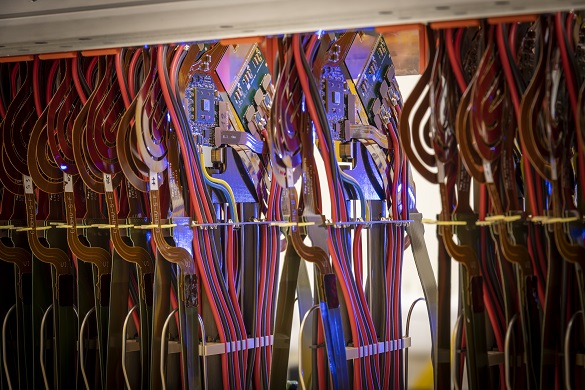
The deep unknown
Why matter survived is not the only mystery in the Universe. There is another issue puzzling scientists: what might dark matter be?
Dark matter is an elusive, invisible type of matter that supplies the gravitational glue to keep stars moving around galaxies. Because we do not yet know what dark matter is, it could be that there are other, new particles and forces in the Universe that we have not yet seen.
Discovering anything new could reveal a radically different picture of nature to the one we have.
New particles like these could announce themselves by subtly changing the way the particles we can see behave, leaving small but detectable traces in our data.
The beauty and charm of VELO
The new VELO detector, which will replace the old VELO detector, will be used to investigate the subtle differences between matter and antimatter versions of particles that contain subatomic particles known as beauty quarks and charm quarks.
These exotic quark-containing particles, also known as B and D mesons, are produced as a by-product of collisions within the Large Hadron Collider (LHC). They are difficult to study because mesons are very unstable and decay out of existence within a fraction of a fraction of a second.
When they decay, however, they actually transform into something else and scientists believe that, by studying these different decays and their properties, VELO data will help LHCb to reveal the fundamental forces and symmetries of nature.
The new VELO detector will sit as close as possible to where the particles collide within the Large Hadron Collider beauty (LHCb) experiment. Given that these particles decay in less than a millionth of a millionth of a second and travel only a few millimetres, this close proximity will give the device the best possible chance of measuring their properties.
VELO’s sensitivity and proximity to the LHC’s beams will allow it to take incredibly precise measurements of the particles as they decay. By comparing these readings to predictions made by the Standard Model (the guiding theory of particle physics) scientists can look for deviations that might hint at new particles in nature, CP violations, or other reasons why matter and antimatter behave differently. These deviations could revolutionise our understanding of why the Universe is what it is.
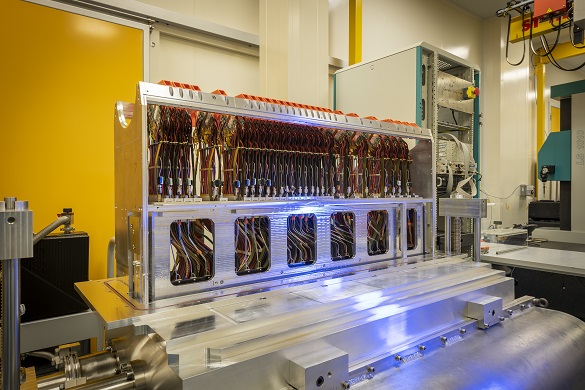
Building on the legacy of the old
New VELO may be brand new and cutting-edge, with its state-of-the-art pixel detector made up of grids of tiny squares of silicon that gives fantastically high-resolution even in the challenging radiation environment near the LHC beams, but it will be building on the legacy of the previous VELO detector.
Its predecessor, with its lines of stacked silicon detectors, helped the LHCb make discoveries including new states of matter, incredibly rare beauty quark decays, differences between matter and antimatter charm quarks, and even the first intriguing indication of as yet unexplained behaviour in beauty quark decay.
UK VELO project leader Professor Themis Bowcock, from the University of Liverpool, said: “The data captured by the old VELO detector has given us really tantalising glimpses of particle behaviour. To make progress, we need to turn this into a really thorough, forensic investigation and this is where the new VELO detector comes in. It gives us the precise set of eyes we need to observe particles at the level of detail we need. Quite simply, the VELO makes our whole physics programme possible on LHCb.”
New VELO will be able to capture these decays in unprecedented detail. Couple this with upgraded software and super-fast readout electronics that will allow beauty and charm quarks to be pinpointed in realtime, and scientists will have a device that allows them to track and analyse decays that were previously too difficult to reconstruct.
What also makes the new VELO detector unique is that scientists can lift it out of the way as they prepare the particle beams for collisions, then move it mechanically into place when LHCb is ready to collect data. This allows scientists to capture clear information from the first particles that radiate from the collisions without unnecessary wear and tear from the beam.
